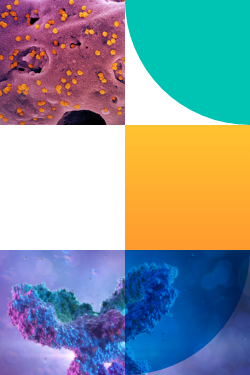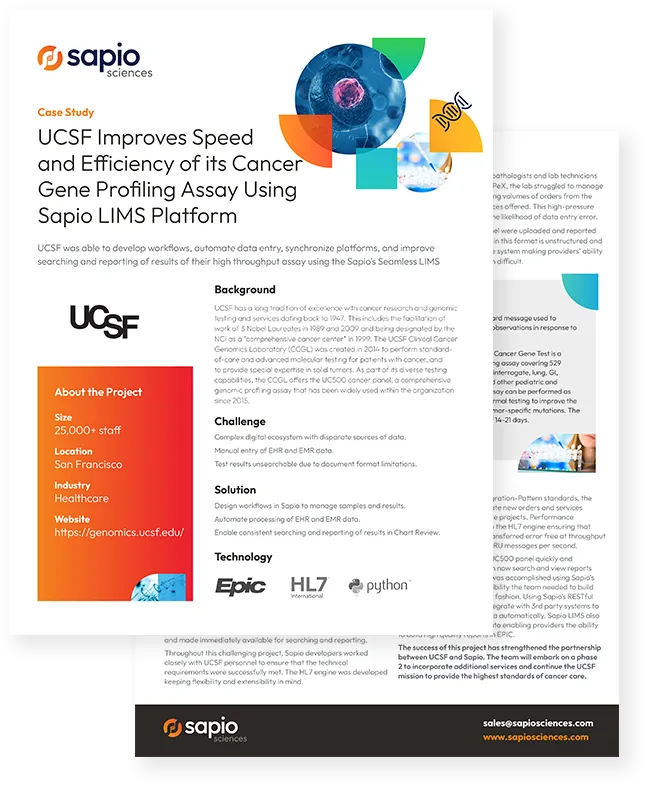

Lab Informatics Resources
Free tools and resources on science-aware™ lab informatics.
Case Study: UCSF Improves Cancer Gene Profiling Speed and Efficiency with Sapio LIMS

Executive Summary
UCSF’s Clinical Cancer Genomics Laboratory (CCGL) faced challenges with disparate data sources, manual data entry, and unstructured reporting for its high-throughput UC500 cancer panel. By partnering with Sapio Sciences and leveraging the Sapio LIMS, UCSF developed workflows, automated data entry, and synchronized platforms. This solution transformed unstructured PDF results into searchable data, enabling providers to quickly find and report information directly within their APeX system, significantly improving the speed and efficiency of their cancer gene profiling assay.
The Customer: UCSF Clinical Cancer Genomics Laboratory (CCGL)
Company Overview
UCSF has a long tradition of excellence with cancer research and genomic testing and services dating back to 1947. This includes the facilitation of work of 3 Nobel Laureates in 1989 and 2009 and being designated by the NCI as a “comprehensive cancer center” in 1999. The UCSF Clinical Cancer Genomics Laboratory (CCGL) was created in 2014 to perform standard-of-care and advanced molecular testing for patients with cancer and to provide special expertise in solid tumors.
Background
As part of its diverse testing capabilities, the CCGL offers the UC500 cancer panel, a comprehensive genomic profiling assay that has been widely used within the organization since 2015.
The Challenge: Data Silos, Manual Entry, and Unstructured Reporting
Despite having a digital ecosystem for managing the UC500 panel, the CCGL had three major issues prior to this project. The CCGL suffered from disparate sources of data by using two digital platforms to manage the UC500 panel. For orders, patient, and provider data, the lab used the Advanced Patient-Centered Excellence (APeX) system, an EPIC based EHR and EMR platform used throughout the UCSF organization. To handle workflows and samples related to the UC500 panel, the lab used the Sapio LIMS platform.
Relying heavily on its staff of pathologists and lab technicians to manually enter data into APeX, the lab struggled to manage workloads due to the increasing volumes of orders from the UC500 panel and other services offered. This high-pressure environment also increased the likelihood of data entry error.
The results of the UC500 panel were uploaded and reported to APeX in PDF format. Data in this format is unstructured and cannot be searched within the system, making providers’ ability to find and report information difficult.
The Solution: Sapio LIMS for Integrated Cancer Gene Profiling
Why Sapio Sciences Was Chosen
Realizing the critical bottlenecks of disparate data, manual entry, and unstructured reporting, UCSF partnered with developers from Sapio Sciences to develop a solution. The team’s first task would be to transform unstructured data into a structured format that could be parsed and uploaded. This was achieved through the development of a python script to convert the UC500 results in PDF to Rich Text Format (RTF). Once converted, both the PDF and RTF would be uploaded to Sapio LIMS.
Implementation Overview
Following the team’s first task of transforming unstructured data into a structured format, The next step involved leveraging Sapio’s RESTful API and HL7 engine to create a bi-directional connection between Sapio and APeX. This enabled the patient, order, and provider data to be automatically synchronized with the PDF and RTF documents, creating a complete data package, known as an ADT message. That information could then be sent to APeX, where it is cataloged and made immediately available for searching and reporting.
Throughout this challenging project, Sapio developers worked closely with UCSF personnel to ensure that the technical requirements were successfully met. The HL7 engine was developed keeping flexibility and extensibility in mind.
By following Enterprise-Integration-Pattern standards, the HL7 engine can easily integrate new orders and services the CCGL may desire in future projects. Performance enhancements were made to the HL7 engine, ensuring that data could be queued and transferred error-free at a throughput exceeding 6 ADT, ORM, or ORU messages per second.
UCSF is now able to run the UC500 panel quickly and efficiently, while providers can now search and view reports directly within APeX. All this was accomplished using Sapio LIMS which provided the flexibility the team needed to build complex workflows in a rapid fashion. Using Sapio’s RESTful API, the team was able to integrate with 3rd-party systems to synchronize and transfer data automatically. Sapio LIMS also automates the transfer of data, enabling providers the ability to build high-quality reports in EPIC.
Key Features
- Sapio LIMS: Provided the flexibility needed to build complex workflows rapidly.
- Sapio’s RESTful API: Enabled integration with 3rd-party systems for automatic data synchronization and transfer.
- HL7 Engine: Created a bi-directional connection between Sapio LIMS and APeX, developed with flexibility and extensibility using Enterprise-Integration-Pattern standards.
- Python Script Development: Used to convert UC500 results from PDF to RTF for structured data.
- Automated Data Transfer: Enabled providers to build high-quality reports in EPIC.
- ADT Message Creation: Facilitated the creation of complete data packages (patient, order, and provider data synchronized with PDF/RTF).
The Results: Improved Speed, Efficiency, and Searchable Reporting
UCSF is now able to run the UC500 panel quickly and efficiently, while providers can search and view reports directly within APeX.
Key outcomes of the Sapio LIMS implementation include:
- Accelerated Operations and Enhanced Data Integrity: UCSF can now run the UC500 panel quickly and efficiently, thanks to automated synchronization and transfer of patient, order, and provider data. HL7 engine performance enhancements ensure high-throughput data transfer exceeding 6 ADT, ORM, or ORU messages per second, significantly reducing reliance on manual data entry and mitigating the likelihood of errors. Complete data packages (ADT messages) ensure all relevant information is linked and available.
- Improved Data Accessibility and Seamless Platform Integration: Providers can now search and view UC500 panel reports directly within APeX, as unstructured PDF data is transformed into a structured, searchable RTF format. This is facilitated by a successful bi-directional connection between Sapio LIMS and APeX, along with integration with third-party systems for automatic data synchronization, enabling providers to build high-quality reports in EPIC.
Lessons for Clinical Genomics Labs
This project highlights critical considerations for clinical genomics laboratories seeking to optimize high-throughput assays and integrate disparate systems:
- Address Data Silos Proactively: Identify and integrate fragmented data sources to create a unified view, crucial for managing complex assays and increasing sample volumes.
- Automate Data Entry: Reduce reliance on manual data input to improve efficiency, minimize errors, and free up staff for higher-value tasks, especially in high-pressure environments.
- Transform Unstructured Data: Develop strategies to convert unstructured data (e.g., PDF reports) into structured, searchable formats to enhance data accessibility and reporting capabilities.
- Leverage API and Integration Engines: Utilize robust APIs and industry-standard engines (like HL7) to create seamless, bi-directional connections between LIMS and EHR/EMR systems for automatic data synchronization.
- Prioritize Flexibility and Extensibility: Choose informatics platforms and integration solutions designed with flexibility and extensibility in mind to accommodate current needs and future service expansions without requiring extensive custom coding.
- Ensure High-Throughput Data Transfer: Implement solutions capable of high-volume, error-free data transfer to support increasing workloads and maintain fast turnaround times.
Next Steps
The success of this project has strengthened the partnership between UCSF and Sapio. The team will embark on a phase 2 to incorporate additional services and continue the UCSF mission to provide the highest standards of cancer care.
Conclusion
UCSF’s Clinical Cancer Genomics Laboratory has significantly improved the speed and efficiency of its UC500 cancer gene profiling assay through a strategic partnership with Sapio Sciences. By leveraging the flexibility of the Sapio LIMS, developing custom scripts, and implementing a robust HL7 integration, UCSF successfully overcame challenges of data fragmentation and manual processes. This has resulted in automated data synchronization, searchable reporting within APeX, and a strengthened foundation for future advancements in cancer care.
Download the Case Study
Technical Definitions
- ADT Message – The most widely used HL7 international standard message used to communicate patient health information.
- APeX – Advanced Patient-Centered Excellence is UCSF’s electronic EPIC based, Medical Record System (EMR) and electronic health record (EHR) system data dating back to 2012.
- HL7 – A set of international standards used to transfer data between software applications used by various healthcare providers.
- ORM – HL7 international standard message used to communicate order information, commonly a request for materials or services.
- ORU – HL7 international standard message used to communicate patient’s clinical observations in response to an ORM message.
- UC500 Panel – The UCSF 500 Cancer Gene Test is a comprehensive genomic profiling assay covering 529 cancer-related genes that can interrogate lung, GI, neurological, gynecological and other pediatric and adult tumors. The UCSF500 assay can be performed as tumor only or paired tumor-normal testing to improve the accuracy of identification of tumor-specific mutations. The assay has a turnaround time of 14-21 days.
FAQ
Q: What challenge did UCSF face with their cancer gene profiling?
A: UCSF’s Clinical Cancer Genomics Laboratory struggled with data silos, manual data entry, and unstructured reporting for the UC500 panel.
Q: How did Sapio LIMS help UCSF?
A: Sapio LIMS automated data flow between platforms, enabling structured, searchable UC500 reports directly within APeX.
Q: What technologies were implemented?
A: Sapio’s RESTful API, a custom HL7 engine, and a Python script converted PDF data into RTF for structured integration.
Q: What were the key outcomes?
A: Faster assay turnaround, reduced manual errors, and improved provider access to genomic insights.


